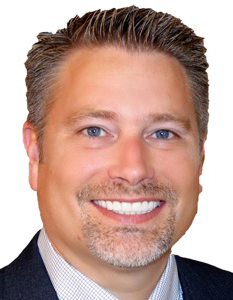By Torrey Carlson, OD

May 8, 2019
Your patients experience your office at many touch points, from the initial phone call, e-mail or text scheduling an appointment, to the check in, through the exam, all the way to the final check out, when they pay for goods and services.
Here’s how my five-location practice in Tennessee, which delivers over 30,000 comprehensive exams annually, ensures that the whole experience is amazing, and the kind that the patient would refer friends and family to experience.
Evaluation Process Begins Immediately
Our patient experience evaluation starts before our patients leave the office. At check out, our staff asks our patients if all their questions were answered. If not, we immediately retrieve the examine doctor to answer any remaining questions. We always ask “how was your digital eye examination today?” Our goal is to try to address any questions or concerns while they are still in the office. After the patient leaves, our automated system sends out a thank-you e-mail or text that includes a brief survey.
Look for Themes in the Reviews You Receive
We look at the reviews for common themes. We first question we ask is: “Would you recommend us to others?” We also ask about staff friendliness, if the patient felt their chief complaints were addressed, how they rate our exam technologies and how long did they have to wait. We look at wait times recorded. We have check-in times and check out-times recorded in our EHR, so we can see if the real patient wait times match the perceived wait times. If there are common themes, we address them as soon as possible. This process allows us to make changes promptly.
Other Articles to Explore
For example, we recently had a review in which the patient complained that it took too long to receive their contact lenses. They were custom-made lenses that usually take up to two weeks to come in. A newer technician had checked out the patient and told them they would be in within a few days.
We used this as a teaching experience, and a reminder in setting proper expectations and trying to exceed them.
We then called the patient to apologize, and explained what had happened. We also followed up with the contact lens company to track the estimated delivery time, and kept the patient up to date on the lens arrival.
Use Technology to Alert You to Patient Experience Shortcomings
We use a dashboard management system for patient communications that allows us not just to carry out appointment recall and patient reviews and surveys, but also shows us the reviews we’re getting from sites like Google Reviews and Yelp, so that we can respond immediately when there is a compliment or complaint.
We get patient survey alerts to our dashboard and my personal e-mail account when a survey shows that we did not meet the expectations of patients, including the amount of time the patient spent in our office. The patient surveys are broken out by location. There is common training for all locations, but each location has its unique challenges, from office layout to patient load. Our busiest locations have longer wait times, and therefore, have slight differences.
I have set up the dashboard system to alert me to any patient who reports on the survey that their appointment took 45 minutes, or longer. I chose to be alerted with this particular amount of time after reading the results of a Johnson & Johnson study on wait times and purchasing behavior that showed a large decrease in purchase amounts from patients who waited more than 45 minutes.
The study also showed that if a patient sat unattended by staff for more than 15 minutes, their spending habits and satisfaction decreased. I believe this is especially true of Millennials and Generation Z patients, as this generation has been groomed to expect instant gratification.
When we get this wait-time information, we review the actual check-in and check-out time and review the patient load, staffing and diagnoses codes, so we can determine why the appointment took so long. Usually, my office managers respond to alerts of long patient wait times, but I have also personally called some of the patients whose appointments took more 45 minutes, or longer.
Our staff responds to both positive and negative reviews as promptly as possible.
Use the Net Promoter Score System to Quantify Patient Experience
The basics of the net promoter score (NPS) is measuring how many patients have had a great experience and are actively promoting your practice. In our surveys, we ask the question, “On a scale of one to 10, how likely are you to recommend us to friends and family?”
The promoters are the 9 and 10’s and the detractors are the 1’s through 6’s. Your score is the percentage of promoters minus the detractors. Our practice goal is 85 percent or higher promoters.
The 7-8 are not included as they are passives and most likely wouldn’t be actively recruiting patients. If we achieve an 8 or lower, we consider this a miss, as we did not make a connection with our patient. We might have done OK, but didn’t give our patients a “wow,” or amazing, eyecare experience.
Set Goals for Improvement
Our goal for the ideal patient experience is that the patient does not wait in any area of our office for more than 15 minutes.
We have patient work-up-time goals. We have established a process where we try to reduce or eliminate the patient’s pain points during their office visit.
For instance, our patients don’t fill out medical history forms. We do an oral history instead. This allows patients to start their exam almost immediately when they get to the office. The majority of the time we already have their insurance eligibility and benefits looked up and authorized.
We ask our staff to engage patients if they have been waiting in the office. This means small talk, asking if they would like a water or coffee, or anything else, like a magazine, to keep them occupied. We also direct patients to the optical to browse during wait times, and we update them on how much longer it should be.
Do a Walk-Through of the Patient Experience
It is always a good idea to put yourself in your patients’ position. Everyone should sit in their own reception area. Go through the exam process with your staff, time your staff and coach for efficiency. We have changed out chairs, added music, TV screens, trash cans and complimentary beverages as a result of these walk-throughs and patient survey feedback. Anything we can do to try to resolve a perceived wait is worth trying.
We also do a quarterly patient journey meeting with our lead doctors and managers. We take every step from scheduling, to check in, to the exam, to thank you e-mails and recall messages to try to make a better patient experience. We talk through what works, and what doesn’t, and try to adapt and trial other methods.
Make Changes
Our biggest changes have been in eliminating the busy work patients have to do, and having our staff look up patients’ insurance benefits prior to their arrival in the office. We now quote our patients their charges before we start, as patients’ understanding of their benefits always rated poorly in our surveys in the past.
Our biggest challenges going forward are smart scheduling and patient flow. Smart scheduling means looking at the books to see if there are patients who need more time, such as scheduling the tough contact fittings where we have more time for them. We also try to fill our least popular slots early for those who don’t have time preferences, and save the popular slots for those who need to be accommodated.
Our NPS has steadily climbed from the mid 70’s to the 85-92 range for each office, and all our offices are now consistent with each other. We also have had exam growth every year for the past 15 years.
We talk to our doctors and staff about the connection we need to make with our patients. We present patient cases to our staff at our monthly meetings to emphasize what a difference we are making in people’s lives. Many times we get caught up in the day-to-day tasks, and we have to step back and appreciate the work we do.
 Torrey Carlson, OD, is the owner of Dr. Carlson & Associates, a five-location practice in the Knoxville, Tenn., area. To contact him: tjcarlsonod@gmail.com
Torrey Carlson, OD, is the owner of Dr. Carlson & Associates, a five-location practice in the Knoxville, Tenn., area. To contact him: tjcarlsonod@gmail.com
.

























